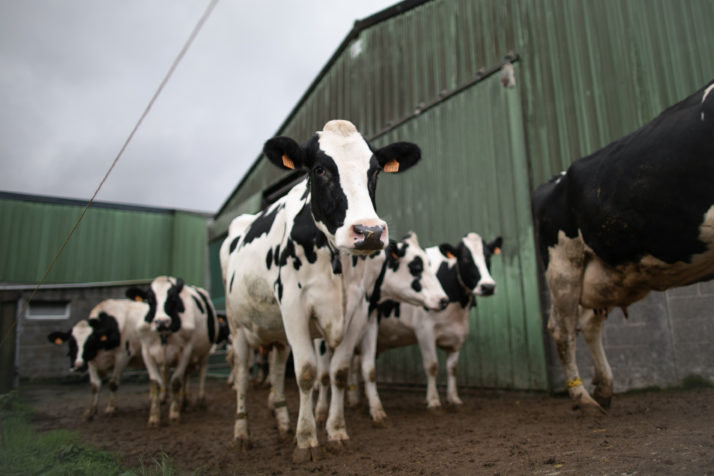
The barrels climbed to $2.4250 last Tuesday, highest CME price since Sept. 25, 2014 and 6.5 cents shy of their record high $2.49 on Sept. 22, 2014. They reversed direction Wednesday and closed Friday at $1.3325, down 2.75 cents on the week, 72.75 cents above a year ago, and 18.75 cents below the blocks.
Monday’s trading took the blocks 2 cents lower and stayed there Tuesday at $2.50 per pound, as traders analyzed the morning’s Global Dairy Trade results and awaited fresh news on the next round of Uncle Sam’s Food Box Program and Thursday afternoon’s May Milk Production report.
The barrels were down 1.25 cents Monday but they reclaimed a half-cent Tuesday, inching back to $2.3250.
Midwest cheesemakers continue to produce actively, reports Dairy Market News. Spot milk offers were sparse for some while others were still finding deals. Plant managers are using more nonfat dry milk to fortify production. Demand has backed off a bit. Pipelines, which were depleted in the midst of the COVID-19 related closures, have been or are closer to being refilled, plus the unprecedented cheese price surge throughout May and into early June have given buyers some hesitation.
The western cheese market is gaining momentum. Food service and government purchases continue to be some of the driving force and the retail sector is taking steady loads. Contacts say Cheddar is particularly hard to find and many processors have their clients on allocation programs even as plants were making all the cheese they can, according to DMN.
Butter’s Friday finish was at $1.87 per pound, down 5.5 cents on the week and 49.5 cents below a year ago, with 22 cars changing hands. In case you’re wondering, the highest CME butter price was $3.1350 per pound on Sept. 25, 2015.
The butter melted down 2.25 cents Monday and lost another 2.5 cents Tuesday, dipping to $1.8225 per pound.
Food service orders for butter, although steadying, have continued to rise but are still half to just over half of what they were last year, according to contacts. Retail customers remain busy but again, concern remains regarding fall inventories and how much butter will be available during the busier ordering season.
Another factor is cream availability, or lack thereof. Spot cream prices are “financially out of reach for butter plant managers,” says DMN.
Retail sales are the driving force for the western butter industry and while that demand has backed off in recent weeks it is still strong and well ahead of normal for this time of year. Some manufacturers say they would normally be building stocks for their end of the year holiday needs but currently have more retail orders than they can fill. Heavy ice cream production is pulling at cream supplies and pushing multiples out of reach for butter makers.
Spot Grade A nonfat dry milk dipped to 95.25 cents per pound last Tuesday, then headed back up and closed Friday at $1.0050 per pound, 2.75 cents higher on the week but 4.75 cents below a year ago, with 24 sales reported. Its highest CME price was $2.16 per pound on Dec. 5, 2007.
Monday’s powder added 0.75 cents and it stayed put Tuesday at $1.0125 per pound.
CME dry whey closed Friday at 31.25 cents per pound, down 3.25 cents on the week and 5 cents below a year ago, on 40 trades, highest since January. The highest CME dry whey price was 57.50 cents per pound on Oct. 17, 2018, 31 weeks after it first started trading at the CME.
The whey lost 0.75 cents Monday but gained a penny Tuesday, inching back to 31.50 cents per pound.
Estimates raised
The Agriculture Department raised its 2020 milk production estimate for the second month in a row in the latest World Agricultural Supply and Demand Estimates report, based on higher expected cow numbers, though I would submit that making predictions in this post-COVID economy is like nailing Jello to a tree.
Price forecasts for cheese, butter and nonfat dry milk were raised on recent price strength and stronger anticipated demand but the whey price forecast was lowered from last month. Class III and Class IV milk prices were raised for 2020.
The 2021 milk production forecast was also raised from last month on higher expected cow numbers and stronger growth in milk per cow. Cheese, butter and nonfat dry milk price forecasts were raised while whey again was lowered. The 2021 Class III and Class IV price forecasts were raised from last month as well.
2020 production and marketings were estimated at 222.5 billion and 221.5 billion pounds, respectively, up 100 million pounds on production and 200 million pounds on marketings, from their May estimate. If realized, 2020 production would be up 4.1 billion pounds or 1.9% from 2019.
2021 production and marketings were estimated at 225.3 billion and 224.3 billion pounds respectively, up 1.2 billion on both production and marketings. If realized, 2021 production would be up 2.8 billion pounds or 1.3% from 2019.
Look for a 2020 Class III price average of $15.65 per hundredweight, up $2.30 from the bleak forecast a month ago, and compares to the $16.96 average in 2019 and $14.61 in 2018.
Adding the current five-month Class III average to June 15 Class III settlements, however, portends a 2020 average of $16.70. The 2021 Class III average was projected at $15.10, up 90 cents from what was expected a month ago.
The Class IV average was projected at $13.55 for 2020, up $1.65 from last month’s estimate, and compares to $16.30 in 2019 and $14.23 in 2018. The 2021 Class IV average is now put at $13.35, up $1.15 from a month ago.
GDT up 1.9%
Milk powder powered Tuesday’s Global Dairy Trade auction as the weighted average was up 1.9%, following a 0.1% gain on June 2. Sellers brought 47.2 million pounds of product to market, down from 48.4 million on June 2.
Skim milk powder led the gains, up 3.1%, following a 0.5% slip last time.
Whole milk powder was up 2.2%, after gaining 2.1%, and GDT Cheddar was up 1.4% after dropping 5.3% last time.
Lactose inched 0.4% higher and anhydrous milkfat was up 0.8%, following a 2.9% descent last time.
Butter was the only decline, down 1.0%, after dropping 4.4% last time.
FC Stone equated the GDT 80% butterfat butter price to $1.5920 per pound US, down 1.5 cents from the last event. CME butter closed Tuesday at $1.8225. GDT Cheddar cheese equated to $1.6469 per pound, up a nickel, and compares to Tuesday’s CME block Cheddar at $2.50. GDT skim milk powder averaged $1.1834 per pound, up from $1.1477, and whole milk powder averaged $1.2833, up from $1.2522. CME Grade A nonfat dry milk closed Tuesday at $1.0125 per pound.
Wrong signal
Class III milk futures look pretty promising, with the June contract hovering well north of $20 per hundredweight. Those prices beg the question: Will dairy farmers respond by turning the milk spigot back on?
FC Stone dairy broker, Dave Kurzawski, answered in the June 15 “Dairy Radio Now” broadcast that “eventually higher prices will obviously call for more milk production,” but he added that we’re entering the hot time of the year and that will temper milk output, even though dairy farmers have learned ways to counteract some of that, but another issue is the restrictions on farmers from milk handlers. He pointed out that “there are still some major milk handlers out there that have producers under restriction.”
He adds that “we’re under a new paradigm of testing in this post-COVID world,” and warned that we may be over shooting the mark in terms of reducing fresh fluid milk production.
“I find it hard to believe you can get to a $2.50 cheese price with ample milk supplies,” he said, but he believes processing capacity may be the bigger problem for cheese and probably for butter as well.
Restaurant trade is the wild card and how comfortable consumers will be dinning out again and feeling safe. Kurzawski says, “They want to,” but he questions how successful restaurants will be with the restrictions placed upon them, if seating capacity is halved.
There in Chicago, you can’t dine inside yet, he said. You can dine outside but rain, hot weather and other factors will impact that.
The bottom line, he concludes is “It’s going to be a really wonky demand story from a restaurant perspective, at least for the next several months.”
























